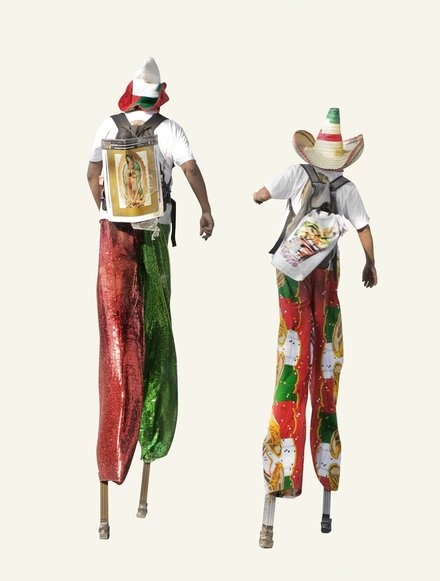
Alinka Echeverria was born in Mexico City in 1981. Her work explores the boundaries between documentary and fine art. With a background as a visual anthropologist, she charts ritualistic behaviour with an inquisitive eye, observing the use of imagery within these and transforming her subjects into a conceptual representation.
Her series, ‘The Road to Tepeyac’, for which she won the prestigious French prize HSBC Prix pour la Photographie is a typology of the backs of three hundred Mexican pilgrims on their journey to the Basilica de Guadalupe in Mexico city. This yearly pilgrimage is undertaken by approximately six million devout Catholics on the anniversary of the apparitions of the Virgin of Guadalupe in 1531 to the indigenous man Juan Diego. This journey is a manifestation of the iconic power of the Virgin, whose image was miraculously imposed onto Juan Diego’s cloak. Belief in the apparitions and their evidence, the ‘sacred image of a miracle and a miracle of images’, marks a turning point in the struggle for power of the Spanish conquerors, for whom evangelization was imperative to the success of the empire. They successfully conquered the imaginaire using imagery as a tool for acculturation and domination in an already extremely visual indigenous culture.
The pilgrims photographed, carry their own reproduction of the Virgin – paintings, sculptures, posters or cloaks of the icon, taken from home and shouldered on their backs to the place of the apparition. The journey is an arduous one, a physical and spiritual undertaking with each pilgrim bearing their own evidence of devotion whilst enforcing their own personal relationship with the Virgin. Echeverria takes each portrait separately, which is then cut and transposed onto a plain background. This de-contextualisation is intended to raise the subject above the corporal world, making them appear like an isolated icon.
Seen as a series, each portrait creates a dialogue with the others. A narrative of interconnecting personal missions removed from the rest of the elements originally in the image. The sheer number of portraits helps to create a visual maze of similarities and differences. With the surrounding landscape removed we are struck by the contrasting richly coloured Virgins and muted tones of the pilgrims.
This series will be presented in a compelling grid of 126 pilgrims; starkly prominent and ordered against the pure white background, giving the audience a dramatic recreation of pilgrimage without losing Echeverria’s isolation of each pilgrim. This is the first time so many works have been presented from this award winning series, which has been exhibited over 15 times internationally.
Meanwhile, the basement space will be darkened creating a quiet ambience presenting an installation of ‘Small Miracles’. This is the first series of work produced by Echeverria since “Road to Tepeyac” and it continues her investigation of the relationship between faith, image and miracle.
The series consists of close up photographs of small good fortune bronze pendants, which are sold by the numerous vendors outside the temple of the miraculous Virgin of Juquila in Oaxaca, Southern Mexico. These tiny objects are representations of miracles requested, such as one of a woman with a baby inside her, which would be pinned to the Virgin’s dress.The interest here is in the image of an image, a mass-produced object, created for commercial gain yet bestowed with personal significance and meaning.
This series is presented in light boxes with a rich wooden frame, thus giving the impression of an elevated altarpiece, with the ‘miracle’ becoming a glowing token of hope mounted on a cardinal red background.
At once we have an art, which encompasses a range of disciplines, there are various associations with analytical documentary practices yet the work transcends a literal interpretation. Echeverria presents a series that challenges our preconceived notions of representational photography. The emphasis is on image layering as pilgrim becomes a separate identity, removed from the physical world, as Christian Caujolle states in the prologue of Echeverria’s HSBC Prix pour la Photographie book – ‘They become image because they carry an interpretation of the image they are going to venerate, and because the only thing photography retains of them is this echo image of another image’.





